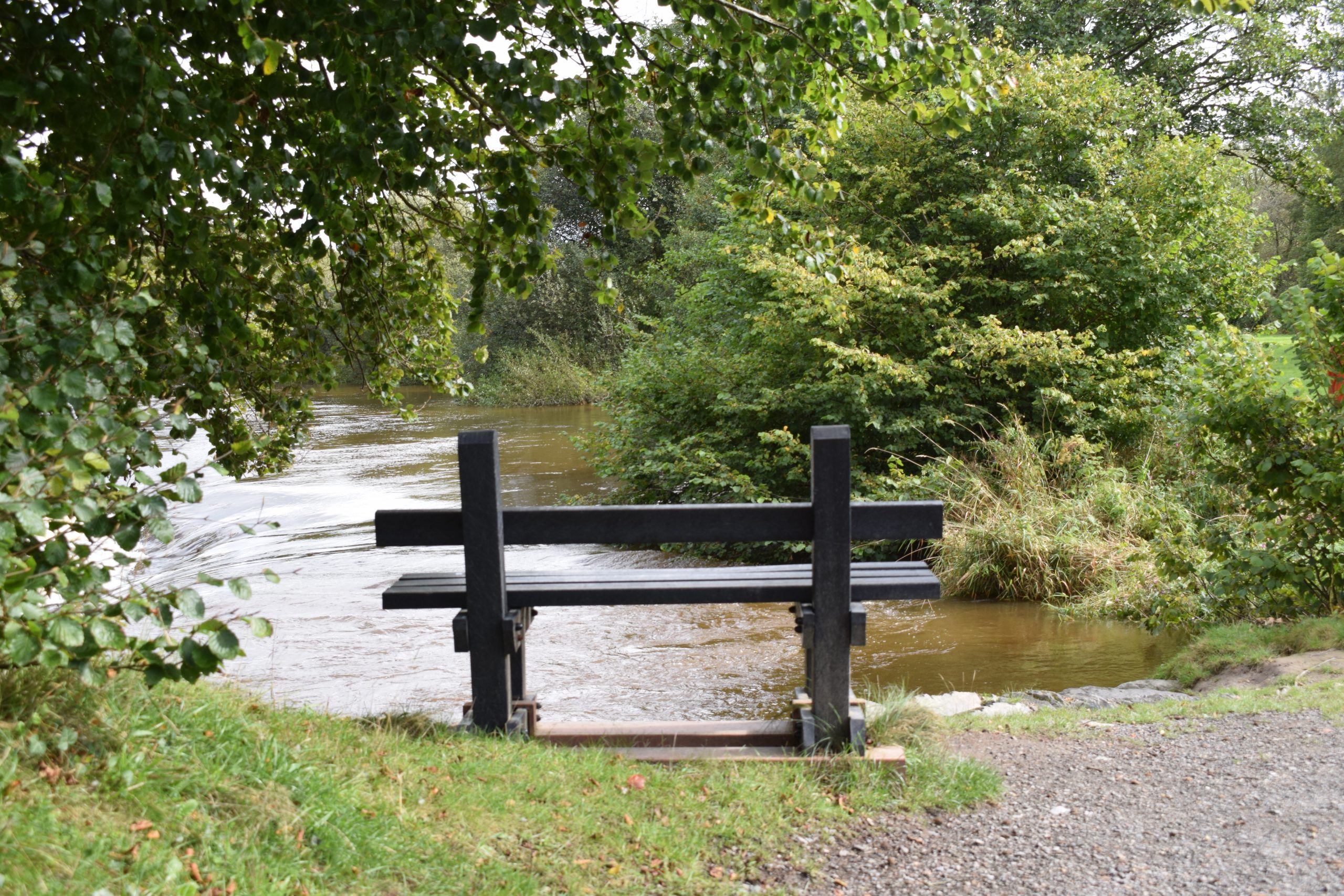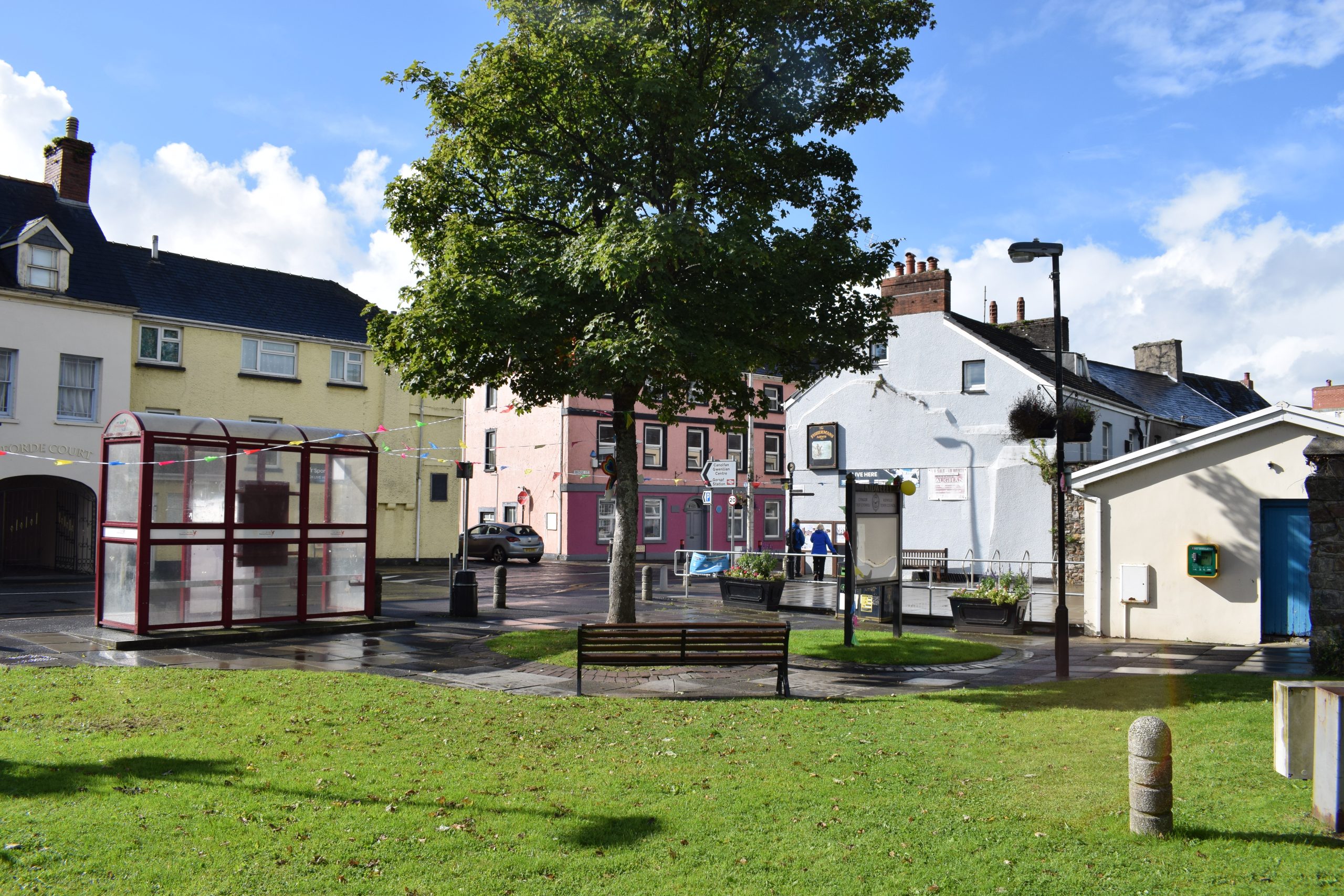Place
Image: Bench overlooking the River Tywi

Why is green and blue infrastructure important for place?
Green and blue infrastructure can make an important contribution to improving the quality and sense of place – sometimes called ‘placemaking’.
Placemaking is about improving the public space in a settlement through an understanding of what makes a local community unique. It should take into account how people use their existing public spaces and what improvements the community would most benefit from.
Heritage features are a key part of any GBI network (see interactive map) and make important contributions to sense of place. They help to tell the story of a place, the landscape that surrounds it and how land use has shifted over time.
The Covid 19 pandemic has accelerated historic trends in the decline of the traditional high street and town centres generally. Wales has one of the highest rates of empty shops in town centres across the UK.
There has been substantial growth in online shopping and home working patterns leading to the closure of shops and re-purposing of office space. Against this backdrop, a GBI-led approach to placemaking is becoming an increasingly attractive option when reconsidering the changing role and function of urban areas.
These trends are forcing authorities more than ever to rethink the shape and purpose of town centres and how to positively respond to longer term changes. This is likely to focus beyond retail and look to residential, leisure, education and community uses – all of which can benefit from a more GBI-led regeneration focus.
What does national policy say?
The ‘Future Wales’ National Plan to 2040 sets the direction for future development in Wales. Policy 2 (Shaping Urban Growth and Regeneration – Strategic Placemaking) requires the growth and regeneration of towns to shape sustainable places, integrated with green infrastructure – informed by a planning authority’s Green Infrastructure Assessment.
Two goals set out in the Well-being of Future Generations (Wales) Act (2015) also have implications for placemaking – ‘A Wales of Cohesive Communities’ and ‘A Wales of vibrant culture and thriving Welsh language’.
The Act defines a cohesive community as an attractive, viable, safe and well-connected community. Just as important is promoting what makes Wales unique – a society that promotes and protects culture, heritage and the Welsh language.
Planning Policy Wales (PPW) sets out the land use planning policies of the Welsh Government. It identifies the integration of green infrastructure as a key placemaking outcome and as an integral part of the design process – designed to deliver ‘distinctive and natural places’. It also requires local authorities to secure wider green infrastructure benefits along transport networks.
What does local policy say?
Strategic Policy SP1 of Carmarthenshire’s Local Development Plan (Sustainable Places and Spaces) requires the shaping of safe, attractive and accessible environments which contribute to people’s health and well-being, promote active travel and integrate biodiversity features. Policy SP15 (on Tourism and the Visitor Economy) highlights the importance of sustainable tourism initiatives which are compatible with the surrounding natural environment.
Carmarthenshire’s 2020 Green Infrastructure Assessment highlights major areas where green infrastructure can contribute to a sense of place, including:
- the visual contribution to landscape.
- the connection to local environment.
- noise absorption.
- heritage and culture.
A series of Recovery Masterplans were created in 2021 for the “core towns” of Llanelli, Carmarthen and Ammanford. The county’s 10 Towns Initiative also looks at a wider network of towns across Carmarthenshire and identifies opportunities for regeneration. These strategies seek to respond to the effects of the Covid-19 pandemic and set out fresh priorities.
These regeneration initiatives are seeking to re-shape public spaces and improving pedestrian environments, through a greater emphasis on experience and ‘place’. GBI has a significant role to play in these efforts.
How is green and blue infrastructure currently serving quality of place in Carmarthenshire?
Image: Existing Pocket Park in Kidwelly town centre

Around the edges of Carmarthenshire’s towns, the attractive upland, estuarine and coastal landscapes mean that the natural environment plays a key role the county’s sense of place.
These are largely semi-rural market towns, many with a strong sense of place and history. Carmarthenshire also has the highest number of Welsh speakers of any county in Wales.
The county also has a strong network of heritage assets – including a number of castles set against dramatic landscapes or seascapes. These are a good example of how the GBI network can provide an important setting for historic environment features
The natural beauty and unspoilt landscapes of the county has created a vibrant tourism and recreation industry that draws in visitors from a wide area – including along the Wales Coast Path. Wales is one of only a few countries in the world to have a continuous coastal footpath stretching its entire coastline.
As a result, tourism is an important sector for Carmarthenshire, and one which depends significantly on the GBI network. In 2019, over 3.4 million visitors came to Carmarthenshire, generating £513 million for the local economy.
Future green and blue infrastructure needs to be sensitive to the sense of place.
What are the challenges and pressures?
Carmarthenshire’s towns represent a valuable opportunity as vibrant ‘stopping off’ points for visitors who are exploring the wider landscapes.
However, while these towns often have the outlines of a rich green and blue network, the poor quality or management of public spaces in some towns can undermine the potential economic and community benefits. In many cases, the towns have also become disconnected from their natural features – notably river corridors.
Some towns have suffered over the years from a lack of investment. Stakeholders consulted for this Strategy recommended that the GBI network could be used to enhance and better “sell” the towns. In particular, this would improve the setting for Carmarthenshire’s impressive heritage assets and help to promote the Welsh language and culture.
Stakeholders also felt there is a lack of green space within towns, with too much ‘hard’ infrastructure in an overwhelmingly car-dominated public realm. Concerns were also raised about the challenge of anti-social behaviour in some of the county’s green spaces.
Many of these green spaces are ‘single-function’ and lack the multifunctionality that characterises strong GBI networks. More multifunctional urban greening features would improve the quality of place while also combatting flood risk and benefitting biodiversity.
Limited space in some of the historic towns can make it difficult to significantly expand on existing green and blue spaces. This calls for a more imaginative way of providing green and blue assets – drawing on a range of green and blue features such as areas of wildflower and SuDS features.
Place: Summary of key issues
Efforts must be made to:
- restore severed connections in the local environment and landscape setting, including river corridors.
- address poor / inconsistent provision of quality landscape and public realm environments in places where people live, work and visit.
- regenerate struggling and uninspiring town centre environments and economies, where cars dominate and some antisocial behaviour occurs.
- restore the sense of place in ex-industrial and rural towns.
- tackle poorly maintained heritage assets and green spaces in several towns.
- promote the connection to the Welsh language and culture.
- maximise the opportunities for promoting nature-led tourism.
- address the often low priority given to positive placemaking and design within new development.